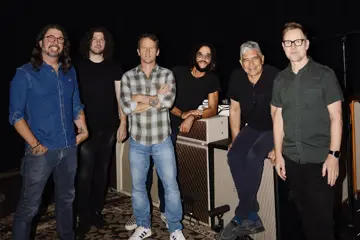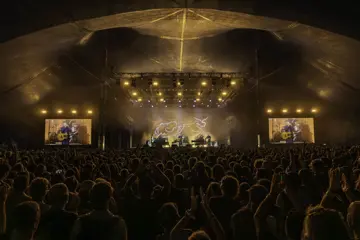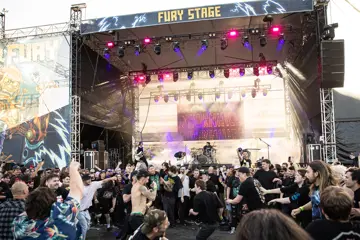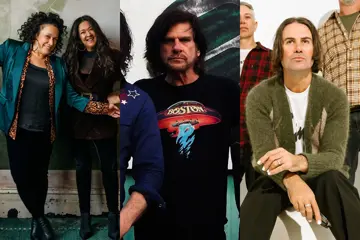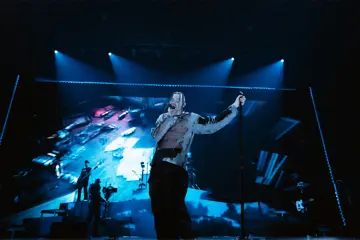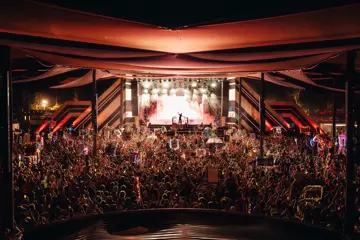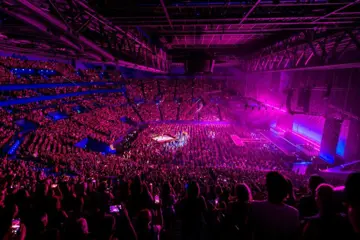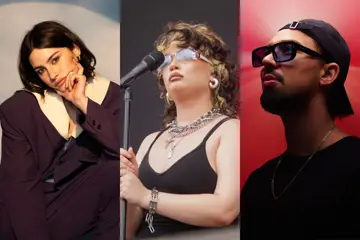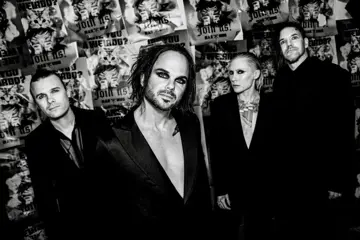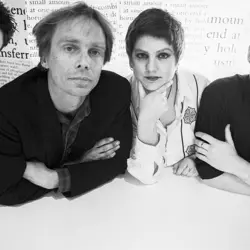 Big Heavy Stuff
Big Heavy Stuff20 Years Of Dear Friends And Enemies.

Credit: Nick Kennedy
The third Big Heavy Stuff album, Size Of The Ocean (2001), was our most successful, which was the result of a number of factors. Not least from our rediscovery of softer melodies and expansive moods. Experiences we had outside of our once-inner city lifestyles through touring and half the band relocating to the mountains started to come through in the music.
Greg Atkinson had once again come up with the goods for what was going to be our 4th long player. He would play guitar and sing into his dictaphone at home and this would be the start of our creative process. Then we’d record most rehearsals onto a cassette that we’d dub for everyone and sit with the songs as we went about our other lives. Great ideas can come when you’re doing something else entirely - I speak for myself when I say I’d be in a different mental space if I didn’t have this in my life.

Credit: Sophie Howarth Photography
This time, we split our practice dates between amped-up rehearsal spaces and intimate acoustic get-togethers in apartments/share houses. High volume can mask a litany of sins, but playing at “room temperature” allows you to get inside the music and hear the details of what is sometimes missed.

Credit: Nick Kennedy
Don't miss a beat with our FREE daily newsletter
With this in mind, we did a house recording for two new tracks with brother Darren (both tacked on the end of the Mutiny EP), which was the beginning of a fairly long, winding, but ultimately rewarding path to Dear Friends And Enemies, (2004).
Once we got the dozen or so new songs into the kind of shape we had in the previous batch before recording SOTO, we once again booked Wayne Connolly to record what we had.
Our preferred studio was David Sykes’ Charing Cross; Wayne’s was Billy Field’s Paradise. Both had closed their doors, at least in part to the upcoming changes already making their presence felt in the industry with affordable home studios.
Shane Fahey’s Megaphon had been recently upgraded to accommodate a lengthy Midnight Oil recording date so all agreed this was the best way forward.

Credit: Nick Kennedy
Wayne taped our well-oiled quartet, performing the 12 tracks we’d been honing for the last six months with minimal overdubs. I started a conversation with Carolyn sometime during the tracking, saying how much I loved The Necks. The next (!) thing I knew, she got on the phone with her old friend Chris Abrahams, and we got him on three tracks, which added a whole new dimension to our music. Just ask Swans and Underworld.
We COULD have stopped there.*
But we didn’t. We had a creative itch we needed to scratch.

Credit: Nick Kennedy
Our friend and engineer on our 1995-1997 recordings at Charing Cross, David Trumpmanis, was preparing to be ready for the new recording revolution by setting up a small overdubbing studio at his family home in Leichhardt. We expressed a desire we had of taking a more collaborative method with him this time, and to also mess a little with whatever formula we may have been using.
The first thing we did was to take a demo of Greg’s that had a very insistent rhythm track on it to see what we could achieve.
The track One Day In Your Life Gone was not recorded with Wayne at Megaphon, but the result of what David did with us in a little suburban room was enough to ask him to produce us.
We agreed he’d take the solid band tracks we’d done with Wayne and build on them to see what the tune bones could handle.

Credit: Nick Kennedy
Sophie Glasson is a wonderful cello player who I’d met playing briefly in the Sydney band Starboard when we recorded an album together called The Night In Question in Paradise with Wayne. It was never released and band leader Chris Moller passed away young, but when Big Heavy Stuff worked with Sophie all our lives were still full of possibilities.

Credit: Nick Kennedy
David tested the mobile capabilities of his new recording set-up and split our recording dates between the inner west and the Blue Mountains, where half the band lived. It was here we recorded the cello parts for four songs, and we’d work with Sophie again on a Bjork cover we’d record at triple j after the album release.
We had all sorts of aspirations for our music, and our influences were wide. We were determined to express this on the new album, possibly as a way of taking back control after our disastrous experience with some aspiring moguls dressed as sheep on our previous album. Friends and enemies, indeed. Not so dear, it turned out.

Credit: Sophie Howarth Photography
Initially, we were quite happy with the Pinback/Grifters hybrid of opener Her Small Mouth that we tracked with Wayne. But we were beginning to realise the affinity we had with artists like DJ Shadow and NEU! who used repetition within the song structure, then mess up the arrangement with a combination of production and editing.
So this is what we did when the next stage happened. We went back to David’s family house (in between their Eurovision parties of course) in order to edit, sand and eq where necessary. This allowed us to go from something heavily fucked with (Only One Thing) to solo piano and vocal (Goliath) and everything in between. We weren’t making Aja, but we also weren’t making Maximum Sincere.

Credit: Nick Kennedy
We had no future plan to upgrade any of our equipment when it came time to playing this stuff live. We would incorporate the new album dynamics into our quartet, and David came on the road with us, playing samples of Sophie and other effects to fill in the gaps. You can hear this on the triple j recording, which captures us at full capacity.

Credit: Nick Kennedy
Matt Lovell may have seemed an odd choice as a mixer when considering all the above - he mainly worked with mainstream and major-label artists. But BHS had that duality in its philosophy. We knew we were delivering pop songs, and we loved that part of it as much as all the experimenting. So poor Matt was charged with making sense of everything we’d contributed to the original tracks, but I believe the results speak for themselves. Watching him and David go to work galvanised a new trust in our vision.
It stands as our definitive statement.



Credit: Nick Kennedy
Remastered in 2024 by Chris Hanzsek, it is now available on super limited and gorgeous double vinyl, CD and cassette in a fresh sleeve design through our partners at Love As Fiction Records.
Wayne did a quick mix of this session, which you can now hear on the digital album, CD album and cassette, Naked Friends And Enemies.
As you’ll hear, his quick mixes are usually as good as many full mixes, and this is pretty close to what the Size Of The Ocean approach to the next album would sound like.
It’s never left the band’s archive before and has been mastered by Chris Hanzsek in 2024.
Play spot-the-difference with the versions despite them both using the same take for each track.

Credit: Sophie Howarth Photography
Available on Live At Triple J 2004 released on Love As Fiction Records.

Credit: Sophie Howarth Photography, Design: Matt Bayes


